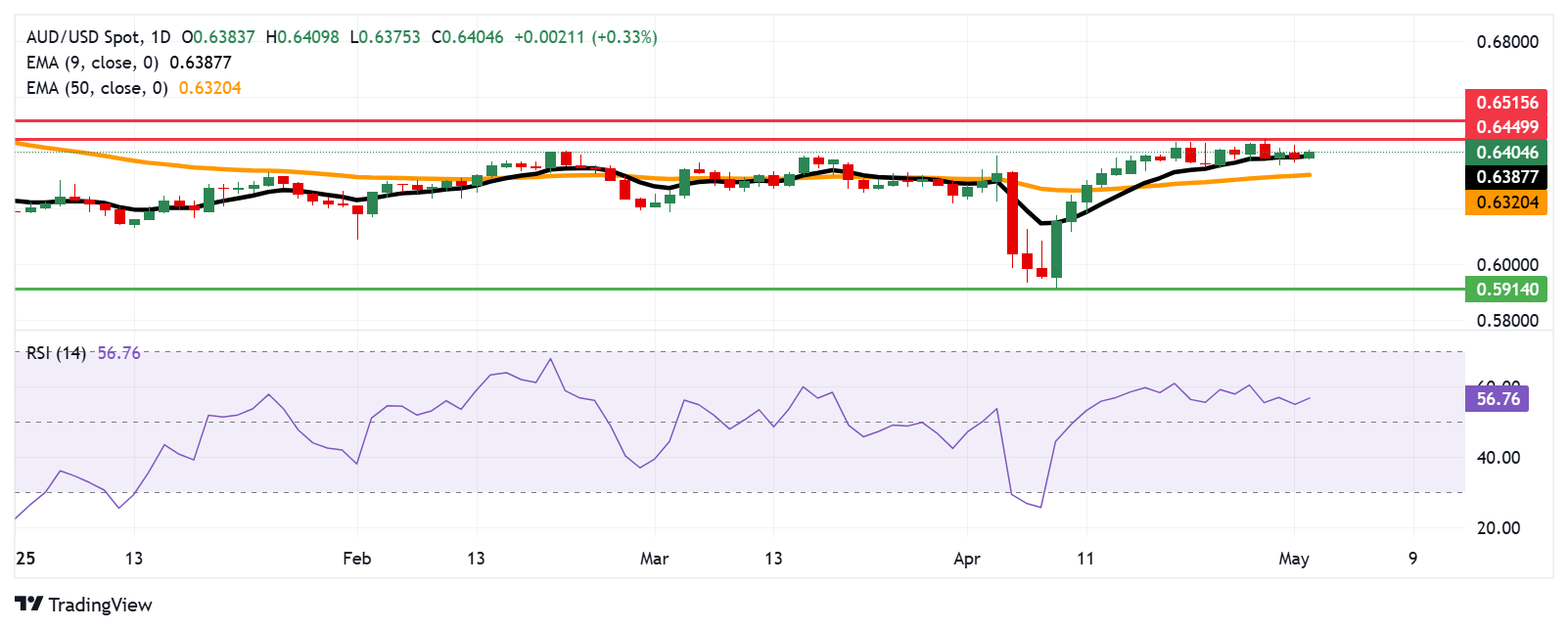Created
: 2025.05.02














![]() 2025.05.02 10:40
2025.05.02 10:40
The Australian Dollar (AUD) is rebounding modestly against the US Dollar (USD) on Friday, retracing some of the previous session's losses. However, the AUD/USD pair remains vulnerable as falling metal prices weigh on sentiment. Key commodities such as iron ore, copper, and gold declined amid renewed concerns over a global economic slowdown, pressuring the commodity-linked Aussie Dollar.
Adding to the pressure, signs of easing US trade tensions have supported the Greenback. Investor sentiment shifted after US President Donald Trump signaled potential trade deals with India, Japan, and South Korea, and expressed optimism about resolving tensions with China.
Australia's Retail Sales--a key indicator of consumer spending--increased by 0.3% month-over-month in March, up from a 0.2% rise in February, according to data released Friday by the Australian Bureau of Statistics (ABS). However, the figure fell short of market expectations, which had forecast a 0.4% gain.
According to Bloomberg, China is considering renewed trade talks with the US. The Chinese Commerce Ministry noted that Washington has reached out to express interest in resuming negotiations. However, China is reportedly conducting an internal assessment and maintains that the US should correct its tariff-related actions, which it views as the unilateral trigger for the ongoing trade dispute.
Australia heads to the polls this weekend, and the outcome presents several risks for the Australian Dollar. Current polling slightly favors incumbent Prime Minister Anthony Albanese, but the race remains tight. A key concern is the possibility of Albanese winning only a minority, forcing him to form a government with the support of the Greens and/or independents--raising the risk of more expansive fiscal policies and potential fiscal slippage. Another short-term risk is the potential for a delayed result, with no clear outcome emerging for several days after the vote.
Meanwhile, inflationary pressures in Australia in early 2025 have weakened expectations of further monetary easing by the Reserve Bank of Australia (RBA). However, markets anticipate a 25-basis-point rate cut in May, as policymakers prepare for possible economic fallout from the recently introduced US tariffs.
The AUD/USD pair is trading around 0.6410 on Friday, maintaining a bullish bias on the daily chart. The pair continues to hold above the nine-day Exponential Moving Average (EMA), while the 14-day Relative Strength Index (RSI) remains comfortably above 50--both suggesting sustained upward momentum.
The AUD/USD pair could find immediate resistance at the recent four-month high of 0.6449, posted on April 29. A decisive break above this level could pave the way toward the five-month high at 0.6515.
On the downside, initial support is located at the nine-day EMA at 0.6387, followed by the 50-day EMA at 0.6320. A breach below these levels could weaken the bullish outlook and may expose the pair to deeper losses, with the March 2020 low near 0.5914 as a distant bearish target.

The table below shows the percentage change of Australian Dollar (AUD) against listed major currencies today. Australian Dollar was the strongest against the Swiss Franc.
| USD | EUR | GBP | JPY | CAD | AUD | NZD | CHF | |
|---|---|---|---|---|---|---|---|---|
| USD | 0.10% | -0.00% | 0.19% | -0.09% | -0.29% | -0.24% | 0.21% | |
| EUR | -0.10% | -0.09% | 0.12% | -0.18% | -0.38% | -0.31% | 0.12% | |
| GBP | 0.00% | 0.09% | 0.17% | -0.07% | -0.28% | -0.21% | 0.22% | |
| JPY | -0.19% | -0.12% | -0.17% | -0.28% | -0.47% | -0.42% | 0.05% | |
| CAD | 0.09% | 0.18% | 0.07% | 0.28% | -0.21% | -0.13% | 0.31% | |
| AUD | 0.29% | 0.38% | 0.28% | 0.47% | 0.21% | 0.07% | 0.51% | |
| NZD | 0.24% | 0.31% | 0.21% | 0.42% | 0.13% | -0.07% | 0.43% | |
| CHF | -0.21% | -0.12% | -0.22% | -0.05% | -0.31% | -0.51% | -0.43% |
The heat map shows percentage changes of major currencies against each other. The base currency is picked from the left column, while the quote currency is picked from the top row. For example, if you pick the Australian Dollar from the left column and move along the horizontal line to the US Dollar, the percentage change displayed in the box will represent AUD (base)/USD (quote).
The Retail Sales data, released by the Australian Bureau of Statistics on a monthly basis, measures the value of goods sold by retailers in Australia. Changes in Retail Sales are widely followed as an indicator of consumer spending. Percent changes reflect the rate of changes in such sales, with the MoM reading comparing sales values in the reference month with the previous month. Generally, a high reading is seen as bullish for the Australian Dollar (AUD), while a low reading is seen as bearish.
Read more.Last release: Fri May 02, 2025 01:30
Frequency: Monthly
Actual: 0.3%
Consensus: 0.4%
Previous: 0.2%
Source: Australian Bureau of Statistics
The primary gauge of Australia's consumer spending, the Retail Sales, is released by the Australian Bureau of Statistics (ABS) about 35 days after the month ends. It accounts for approximately 80% of total retail turnover in the country and, therefore, has a significant bearing on inflation and GDP. This leading indicator has a direct correlation with inflation and the growth prospects, impacting the Reserve Bank of Australia's (RBA) interest rates decision and AUD valuation. The stats bureau uses the forward factor method, ensuring that the seasonal factors are not distorted by COVID-19 impacts.
![]()
Created
: 2025.05.02
![]()
Last updated
: 2025.05.02

FXStreet is a forex information website, delivering market analysis and news articles 24/7.
It features a number of articles contributed by well-known analysts, in addition to the ones by its editorial team.
Founded in 2000 by Francesc Riverola, a Spanish economist, it has grown to become a world-renowned information website.
We hope you find this article useful. Any comments or suggestions will be greatly appreciated.
We are also looking for writers with extensive experience in forex and crypto to join us.
please contact us at [email protected].
Disclaimer:
All information and content provided on this website is provided for informational purposes only and is not intended to solicit any investment. Although all efforts are made in order to ensure that the information is correct, no guarantee is provided for the accuracy of any content on this website. Any decision made shall be the responsibility of the investor and Myforex does not take any responsibility whatsoever regarding the use of any information provided herein.
The content provided on this website belongs to Myforex and, where stated, the relevant licensors. All rights are reserved by Myforex and the relevant licensors, and no content of this website, whether in full or in part, shall be copied or displayed elsewhere without the explicit written permission of the relevant copyright holder. If you wish to use any part of the content provided on this website, please ensure that you contact Myforex.
Myforex uses cookies to improve the convenience and functionality of this website. This website may include cookies not only by us but also by third parties (advertisers, log analysts, etc.) for the purpose of tracking the activities of users. Cookie policy